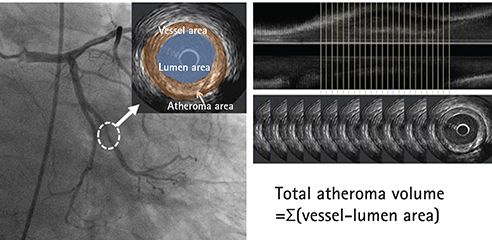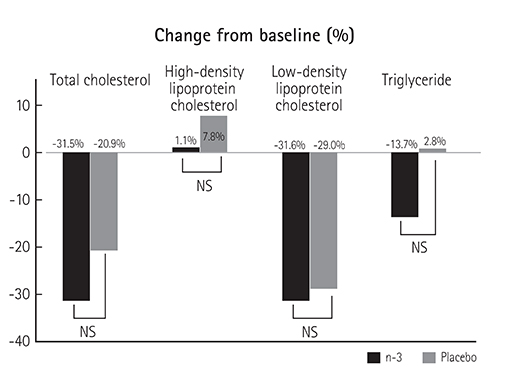Korean Circ J.
2016 Jul;46(4):481-489. 10.4070/kcj.2016.46.4.481.
Effect of n-3 Polyunsaturated Fatty Acids on Regression of Coronary Atherosclerosis in Statin Treated Patients Undergoing Percutaneous Coronary Intervention
- Affiliations
-
- 1Division of Cardiology, Department of Internal Medicine, Pusan National University Hospital, Busan, Korea. glaraone@hanmail.net
- 2Department of Internal Medicine, Busan Medical Center, Busan, Korea.
- 3Department of Biostatistics, Pusan National University Hospital, Busan, Korea.
- 4Department of Cardiovascular Surgery, Pusan National University Hospital, Busan, Korea.
- 5Family Medicine Clinic and Research Institute of Convergence of Biomedical Science and Technology, Pusan National University Yangsan Hospital, Yangsan, Korea.
- 6Medical Education Unit and Medical Research Institute, Pusan National University School of Medicine, Yangsan, Korea.
- KMID: 2344422
- DOI: http://doi.org/10.4070/kcj.2016.46.4.481
Abstract
- BACKGROUND AND OBJECTIVES
Statins remain the mainstay of secondary coronary artery disease (CAD) prevention, but n-3 polyunsaturated fatty acids (ω-3 PUFA) display biological effects that may also reduce the risk of atherosclerosis and CAD. However, data on the possible antiatherosclerotic benefits of adding ω-3 PUFA to statin therapy are limited. This study aimed to investigate the potential additive effects of ω-3 PUFA on regression of atherosclerosis in CAD patients receiving statin therapy and stent implantation.
SUBJECTS AND METHODS
Seventy-four CAD patients undergoing percutaneous coronary intervention (PCI) with stent implantation were enrolled, prescribed statins, and randomly assigned to two groups: n-3 group (ω-3 PUFA 3 g/day, n=38) or placebo group (placebo, n=36). All patients completed the study follow-up consisting of an intravascular ultrasound at baseline and at 12 months.
RESULTS
There was no difference in the baseline characteristics and distribution of other medications. No significant differences were observed in primary endpoints, including changes in atheroma volume index (-12.65% vs. -8.51%, p=0.768) and percent atheroma volume (-4.36% vs. -9.98%, p=0.526), and in secondary endpoints including a change in neointimal volume index (7.84 vs. 4.94 mm3/mm, p=0.087).
CONCLUSION
ω-3 PUFA had no definite additional effect on the regression of coronary atherosclerosis when added to statin in CAD patients undergoing PCI.
MeSH Terms
Figure
Reference
-
1. Kris-Etherton PM, Harris WS, Appel LJ. American Heart Association. Nutrition Committee. Fish consumption, fish oil, omega-3 fatty acids, and cardiovascular disease. Circulation. 2002; 106:2747–2757.2. Cawood AL, Ding R, Napper FL, et al. Eicosapentaenoic acid (EPA) from highly concentrated n-3 fatty acid ethyl esters is incorporated into advanced atherosclerotic plaques and higher plaque EPA is associated with decreased plaque inflammation and increased stability. Atherosclerosis. 2010; 212:252–259.3. Mozaffarian D, Wu JH. Omega-3 fatty acids and cardiovascular disease: effects on risk factors, molecular pathways, and clinical events. J Am Coll Cardiol. 2011; 58:2047–2067.4. Amano T, Matsubara T, Uetani T, et al. Impact of omega-3 polyunsaturated fatty acids on coronary plaque instability: An integrated backscatter intravascular ultrasound study. Atherosclerosis. 2011; 218:110–116.5. Nozue T, Yamamoto S, Tohyama S, et al. A predictor of atheroma progression in patients achieving very low levels of low-density lipoprotein cholesterol. Am J Cardiovasc Dis. 2013; 3:255–263.6. ORIGIN Trial Investigators. Bosch J, Gerstein HC. N-3 Fatty acids and cardiovascular outcomes in patients with dysglycemia. N Engl J Med. 2012; 367:309–318.7. Rauch B, Schiele R, Schneider S, et al. OMEGA, a randomized, placebo-controlled trial to test the effect of highly purified omega-3 fatty acids on top of modern guideline-adjusted therapy after myocardial infarction. Circulation. 2010; 122:2152–2159.8. Wu JH, Mozaffarian D. ω-3 fatty acids, atherosclerosis progression and cardiovascular outcomes in recent trials: new pieces in a complex puzzle. Heart. 2014; 100:530–533.9. Longo DL, Fauci AS, Kasper DL, Hauser SL, Jameson JL, Loscalzo J. Harrison's principles of Internal Medicine. 18th ed. New York: McGrawHill;2012. p. 1983–1991.10. Chang CL, Seo T, Du CB, Accili D, Deckelbaum RJ. n-3 fatty acids decrease arterial low-density lipoprotein cholesterol delivery and lipoprotein lipase levels in insulin-resistant mice. Arterioscler Thromb Vasc Biol. 2010; 30:2510–2517.11. Talayero BG, Sacks FM. The role of triglycerides in atherosclerosis. Curr Cardiol Rep. 2011; 13:544–552.12. Calder PC. n-3 fatty acids and cardiovascular disease: evidence explained and mechanisms explored. Clin Sci (Lond). 2004; 107:1–11.13. Massaro M, Scoditti E, Carluccio MA, De Caterina R. Nutraceuticals and prevention of atherosclerosis: focus on omega-3 polyunsaturated fatty acids and Mediterranean diet polyphenols. Cardiovasc Ther. 2010; 28:e13–e19.14. Nakajima K, Yamashita T, Kita T, et al. Orally administered eicosapentaenoic acid induces rapid regression of atherosclerosis via modulating the phenotype of dendritic cells in LDL receptor-deficient mice. Arterioscler Thromb Vasc Biol. 2011; 31:1963–1972.15. O'Keefe JH Jr, Abuissa H, Sastre A, Steinhaus DM, Harris WS. Effects of omega-3 fatty acids on resting heart rate, heart rate recovery after exercise, and heart rate variability in men with healed myocardial infarctions and depressed ejection fractions. Am J Cardiol. 2006; 97:1127–1130.16. Charnock JS, McLennan PL, Abeywardena MY. Dietary modulation of lipid metabolism and mechanical performance of the heart. Mol Cell Biochem. 1992; 116:19–25.17. Djoussé L, Gaziano JM, Buring JE, Lee IM. Dietary omega-3 fatty acids and fish consumption and risk of type 2 diabetes. Am J Clin Nutr. 2011; 93:143–150.18. León H, Shibata MC, Sivakumaran S, Dorgan M, Chatterley T, Tsuyuki RT. Effect of fish oil on arrhythmias and mortality: systematic review. BMJ. 2008; 337:a2931.19. Marik PE, Varon J. Omega-3 dietary supplements and the risk of cardiovascular events: a systematic review. Clin Cardiol. 2009; 32:365–372.20. Baigent C, Keech A, Kearney PM, et al. Efficacy and safety of cholesterol-lowering treatment: prospective meta-analysis of data from 90,056 participants in 14 randomised trials of statins. Lancet. 2005; 366:1267–1278.21. Dietary supplementation with n-3 polyunsaturated fatty acids and vitamin E after myocardial infarction: results of the GISSI-Prevenzione trial. Gruppo Italiano per lo Studio della Sopravvivenza nell'Infarto miocardico. Lancet. 1999; 354:447–455.22. Nissen SE, Nicholls SJ, Sipahi I, et al. Effect of very high-intensity statin therapy on regression of coronary atherosclerosis: the ASTEROID trial. JAMA. 2006; 295:1556–1565.23. Lee E, Lee S, Park Y. n-3 polyunsaturated fatty acids and trans fatty acids in patients with the metabolic syndrome: a case-control study in Korea. Br J Nutr. 2008; 100:609–614.24. Casula M, Soranna D, Catapano AL, Corrao G. Long-term effect of high dose omega-3 fatty acid supplementation for secondary prevention of cardiovascular outcomes: a meta-analysis of randomized, placebo controlled trials. Atheroscler Suppl. 2013; 14:243–251.25. GISSI-HF investigators. Tavazzi L, Maggioni AP, et al. Effect of n-3 polyunsaturated fatty acids in patients with chronic heart failure (the GISSI-HF trial): a randomised, double-blind, placebo-controlled trial. Lancet. 2008; 372:1223–1230.26. Maki KC, Orloff DG, Nicholls SJ, et al. A highly bioavailable omega-3 free fatty acid formulation improves the cardiovascular risk profile in high-risk, statin-treated patients with residual hypertriglyceridemia (the ESPRIT trial). Clin Ther. 2013; 35:1400–1411.e3.27. Burr ML, Ashfield-Watt PA, Dunstan FD, et al. Lack of benefit of dietary advice to men with angina: results of a controlled trial. Eur J Clin Nutr. 2003; 57:193–200.28. Kromhout D, Giltay EJ, Geleijnse JM. Alpha Omega Trial Group. n-3 fatty acids and cardiovascular events after myocardial infarction. N Engl J Med. 2010; 363:2015–2026.29. Arnesen H. n-3 fatty acids and revascularization procedures. Lipids. 2001; 36:Suppl. S103–S106.



